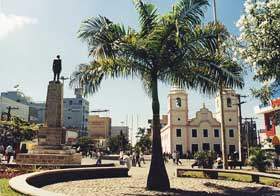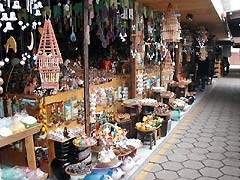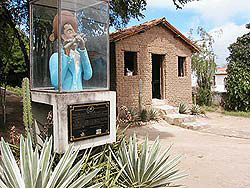|
|
Caruaru - Pernambuco
«Recife
« Cities of Pernambuco
Population: 253.634 inhabitants
Area: 921 km2
Distance from Recife: 130 km
Accesses: BR-232 (double laned all the way from Recife to Caruaru). Visit maps of Recife and Pernambuco.
History
There are a few theories about the origin of the name Caruaru. One of them makes reference to Caruás, which means "water fountain" in indian language. Another theory states that the name may be a variation of Caruari, which means river of the Caruarãs (kind of frog typical of the region).
Caruaru was formed from a big cattle farm, property of Capt. José Rodrigues de Jesus; in 1800, the farmer sold the real estate in pieces, and a small village was formed.
 In 1895, with the arrival of the railways, the city had a large economic boost. Then, it became easier to bring products from the capital Recife for distribution in the cities of the interior of Pernambuco; Caruaru gained importance as a commercial center, which it enjoys until today.
In 1895, with the arrival of the railways, the city had a large economic boost. Then, it became easier to bring products from the capital Recife for distribution in the cities of the interior of Pernambuco; Caruaru gained importance as a commercial center, which it enjoys until today.
The municipality of Caruaru comprises the head district and the districts of Carapotós, Gonçalves Ferreira and Lajedo do Cedro, besides another 10 villages.
Its political emancipation is celebrated on May 18th.
Economy
Caruaru is the largest economical center of the Agreste of Pernambuco (see map of Pernambuco), and one of the largest in the entire Northeast of Brazil (there is a "rivalry" between Caruaru and the city of Campina Grande, in the neighbour State of Paraíba, over the title of Capital of the Agreste).
Besides being office of diverse industrial and commercial establishments, Caruaru exercizes economic influence on the West part of Pernambuco and other neighbour States.
Caruaru is particularly known by its "feiras" (street markets); traders buy goods in wholesales at other major centers (it used to be mostly Recife, but nowadays people go to São Paulo and even Paraguay) and sell them in smaller lots in Caruaru; from Caruaru, smaller resellers distribute the goods all over Pernambuco.
The most famous of such street markets is Feira da Sulanca (sulanca is the local name for products of low price and low quality); actually, several cities have their own Feira da Sulanca, the Caruaru's being the most famous. This feira opens on Tuesdays only (why? because the other days of the week the traders are travelling to purchase goods elsewhere), concentrates about 10,000 stalls and attracts 40,000 visitors. Read more about Feiras de Caruaru.
 Another important cultural and economic activity is the handicraft production (see photo). Much of the clay pottery and wooden pieces sold in shops (particularly airports) of the entire Brazilian Northeast are produced in Caruaru; by visiting one of the Feiras de Artesanato (Handicraft Markets) in Caruaru, visitors can shop for much more diversified and skillful work, for a much better price.
Another important cultural and economic activity is the handicraft production (see photo). Much of the clay pottery and wooden pieces sold in shops (particularly airports) of the entire Brazilian Northeast are produced in Caruaru; by visiting one of the Feiras de Artesanato (Handicraft Markets) in Caruaru, visitors can shop for much more diversified and skillful work, for a much better price.
Agriculture is also important; there are cultures of potato, manyoc, tomato, beans, corn and tropical fruits. The area in Pernambuco to the West of Caruaru is very arid, not propicious for agriculture; Caruaru is an important food supplier fo the region.
Caruaru is part of the Development Region of the Agreste Central. With an area of 10.117 km², the region covers 10,22% of the State territory and is composed by another 25 cities: Agrestina, Alagoinha, Altinho, Barra de Guabiraba, Belo Jardim, Bezerros, Bonito, Brejo da Madre de Deus, Cachoeirinha, Camocim de São Félix, Cupira, Gravatá, Ibirajuba, Jataúba, Lagoa dos Gatos, Panelas, Pesqueira, Poção, Riacho das Almas, Sairé, Sanharó, São Bento do Una, São Caetano, São Joaquim do Monte and Tacaimbó.
Tourism
Caruaru is place for a Figurative Arts center declared by UNESCO as the largest in the Americas, the Alto do Moura, which exhibits works by more than 200 artisans. The center also houses the Museu do Mestre Vitalino (Museum of Mester Vitalino), established in the same house where Vitalino used to live (see photo); Vitalino (1909 - 1963) is considered the greatest pottery artisan of the Northeast of Brazil, and pieces of his work are in exhibition all over the country and the world; read more about Mestre Vitalino. In Alto do Moura, each artist maintains a studio at their own houses; visitors can appreciate the artcraft while being treated as family members.

In June, Caruaru becomes the Brazilian Capital do Forró, and hosts the biggest São João in Brazil (read more about Festas Juninas);
for a long time, Caruaru was the undisputed such capital, but in recent years other cities have been claiming that title (the main competitor being Campina Grande, in Paraíba, and, more recently, Mossoró, in Rio Grande do Norte).
Even though Festas Juninas are supposed to happen in June (hence the name), in Caruaru they start early. Thousands of tourists flock to Caruaru in the period; hotels in the city and neighbourhood are full; the roads get very busy. The city is taken by stalls selling typical food; regional three-men bands (playing a zaboomba, a triangle and an accordion) go about inviting dancers; in the Central Plaza, the crowds dance to the sounds of forró bands.
Tourists in Caruaru can visit the Museu do Forró (one of several Museums in Caruaru), which exhibits photos, clothes, musical instruments, recipes, etc. associated with forró and the São João. Another interesting place is the Vila do Forró, a replica of the original houses of the region, with the original rustic furniture.
More info: Caruaru. Official Portal of Caruaru.
Source of informations: IBGE and Government of the State of Pernambuco
| |